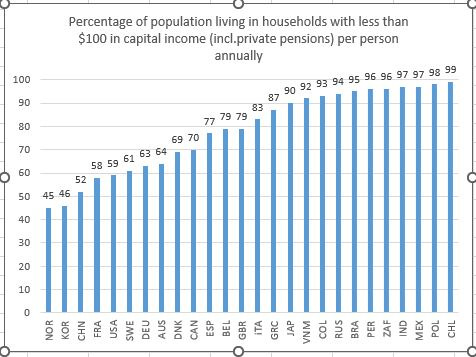How to control increase of income inequality due to new technologies?
Spread, tax and ban
The problem. New technology, like all technological improvements since the Industrial Revolution, aims to replace human labor by machines, broadly understood. In that sense Artificial Intelligence is not different from the self-acting mule introduced in cotton industry in the 1820s: it replaces human labor although now it does it at a higher level of human skills. (In many ways, such developments were forecast because there was historically an inexorable increase in the level of skill of labor that was replaced by machines, beginning with unskilled and repetitive tasks performed by enslaved labor and then rising ever higher.)
From the distributional point of view, the issue is that substitution of labor by capital leads to the larger share of national income accruing to capital. This, translated in terms of actual perrons who receive such income, means that entrepreneurs and inventors of new machines and investors in such new technologies gain disproportionately. Investors, by definition, are people who own capital and who belong to the top strata of income distribution. Thus, the expansion of the capital share almost necessarily translates into an increase in overall income inequality.
This naturally raises the question: what policies should be used to stop or moderate the increase in income inequality? There are three ways in which this can be done: spreading the ownership of capital more widely so that the effect of the rising capital share is not felt only at the top; tax highest capital incomes more than now; and ban some new financial activities that create income for the participants but are “directly non-productive”.
I shall consider the three options.
Spread the ownership of capital. Capital is extraordinarily heavily concentrated. The figure below shows that, on average, 77 percent of households in advanced and middle income economies have zero or close to zero (“close to zero” is defined as $100 per person annually) cash income from capital. It should be noted that capital here includes only financial or productive capital that produces a cash income for its owner. It is not the same thing as household wealth which incudes also own-used housing, jewelry, paintings, furniture etc. The countries with the highest spread of capital income, that is, with the lowest share of “zero capital households”, are Norway, South Korea, and (interestingly) China. Yet even there about one-half of households receives no income from capital. In the United States, that percentage is almost 60 percent and in other advanced countries it exceeds 70 percent. (I discussed this topic in more detail in my previous Substack piece.)
Source: Calculated from individual household data available in Luxembourg Income Study. The data refer to the most recent surveys, conducted between 2018 and 2023. The average of 77 percent is population-weighted.
The issue with respect to AI is, as mentioned above, the following: if so few people have financial and productive capital, its rising importance will simply accrue to those who already own capital assets, will further empower the already rich, and increase inequality. (It may not increase the number of “zero” households; but for inequality to go up, it is sufficient that it makes those on the top even richer).
How to spread capital ownership? The issue has been addressed before with scant results. Margaret Thatcher spoke of “people’s capitalism”. It ended mostly as privatization of council housing. Employee Stock Ownership Plans (ESOP) in the United States were another way to help ownership spread to workers. There results were also small, but as Isabel Sawhill argued it was principally because giving stock to workers was not fiscally encouraged: if companies enjoyed tax benefits when they distribute stocks to workers, there would be probably more ESOPs. In fact, there is no obvious reason why CEOs should be paid in company shares but not workers. In some countries, private pension funds were used, not only to get rid of potentially fiscally unsustainable defined-benefit systems but also to spread income from capital. In the above graph, for example, the share of “zeros” in the UK decreases from 84 percent to 79 percent when income from private pensions is included. All of these methods could be used with a distinct objective of spreading some capital ownership to more people, and thus moderating the increase in income inequality that would quasi automatically follow from greater application of new technologies, including AI.
Tax highest capital incomes. Another rather obvious way to check rising inequality from capital is to tax it. This is often seen as the only solution, but, as I implicitly argued above, taxation should be a solution, but only one among several. Not every problem can be solved by taxation. Capital incomes are, paradoxically, currently taxed in the United States at lower rates than equivalent labor incomes: for example, the marginal tax rate on labor income under $100,000 annually is 24 percent vs. 15 percent for capital; for incomes over $400,000 the gap is even greater: 35 vs 15 percent; see also the forthcoming excellent book by Ray D. Madoff The Second Estate: How the Tax Code Made an American Aristocracy. There is therefore lots of space to increase taxes.
Another method, in many ways equivalent to taxation, is explicit government ownership in new technologies or innovations where government funding played an important role—where in fact, the government might have been the “angel investor”. Such contributions often go unrecognized. Mariana Mazzucato has documented it persuasively in the case of many US Silicon Valley companies. The same thing is probably going on today and governments should not be shy in asserting their right on some of capital income flows. US government’s decision to take a significant stake in Intel can be seen in this light. Such explicit government ownership is even more easily justified in countries like China where, direct and indirect, role of the government in helping innovation is even greater.
Ban some noxious new technologies. A final way to stop new technologies from exacerbating inequality is to simply ban some activities of speculative nature that are directly “non-productive”. This is clearly the most difficult, and the most radical, way to deal with the problem and should be used extremely cautiously. However, it should not be excluded. What is a “non-productive” activity in economics is difficult to establish. In theory, every activity and thus income from that activity based on voluntary transactions between economic actors is justified. But in practice there are limits. Drug or arms sales are in many countries banned even if both can definitely be seen as activities taking place voluntarily between economic agents. With new technologies, there seem to be activities (linked with crypto currencies and financial speculation in general) whose sole objective is speculation. They do not increase the quantity of goods or services, not do they obviously improve the allocation of resources. Many such activities are more like lotteries: they make some rich while impoverishing many. In fact, as Adam Snith in a little noticed passage, noted more than 250 years ago, the greater the lottery, the greater the number of losers. The option of bans should not be left off the table. It should be however exercised judiciously and only in extreme cases where, for example, taxation is difficult or the activity is sufficiently “noxious” or replete with negative externalities so that its ban can be justified.
It is by doing these three things simultaneously, albeit in different proportions at different times, that the government may hope to keep the increase in inequality within acceptable bounds while not dissimulating innovation and introduction of new technologies.



Note that this Luxembourg Income Study capital income metric is very deceiving. The “zero capital households” figure depends a lot on how surveys classify capital income: your definition includes only cash flows from financial or productive assets (dividends, interest, rents, business profits).
It explicitly excludes own-use housing (which is something you can definitely argue for) but often also deferred savings vehicles like pensions if they don’t currently pay out. For example, Swedish residents all have the equity-heavy AP7 Såfa as the default fund in the publicly-administered premium pension (PPM) component of their state pension (equivalent to American Social Security). Basically every Swedish adult is a owner of capital, then. But the equity dividends are re-invested and the income from capital gains deferred until statutory retirement age (when they are paid out more like an insurance scheme, accounting-wise). So the Luxembourg Income Study counts this as labor income deferred, not capital income.
To your point, this doesn't much help a worker rendered unemployed by AI, since they would need income today and not after age 65-67. But, strictly speaking, they are de facto owners of capital and receive capital income... just later.
This might be a way to resolve the perennial "crisis" in Social Security and ideological criticisms thereof: you could add a "premium" or "flexible" aspect funded by Social Security payroll taxes or contributions and default to a lower-cost indexed fund with a conservative 40/60 equity split. Therefore rendering all Americans as owners of capital and investing more national savings in the financial system. You'd still retain the core system to be more inflation-proof and annuity-like, as the Swedish pension system does.
I greatly admire your posts and your analyses as here generally. But you are simply repeating a falsehood when you imply with your term "cryptocurrencies" that all decentralised, open source blockchain technology is simply a lottery/scam without utility and cannot benefit poorer individual investors. If you would learn more you'd say most Web3 chains are not currency although they operate with tokens eventually backed by fiat currencies. They provide access to finance for individuals without middle people; they provide efficiency for transactions; and in many cases provide decentralised, more private for activities currently only provided by centralised sites that mine and sell data and enable surveillance. BTC, Monero, and a few others may be essentially only currencies and these may be scams of a sort. So too Memes. But ETH, Chainlink and a huge range host of blockchains operating on staking are not. They represent an important evolution of the internet that have the potential to expand capital ownership although I will grant you that there is certainly the potential for legacy financial institutions to slowly but surely monopolise Web3. But for now please investigate further and avoid the use of the generic term "cryptocurrency".